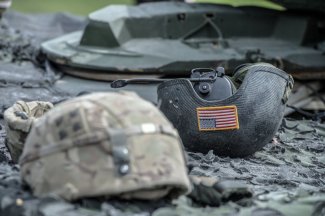German discussion about moving US troops to Poland

On 9th August, in an interview he gave to the German press agency, the US Ambassador to Germany Richard Grenell stated that 'it is offensive to assume that the U.S. taxpayers continue to pay for more than 50,000 Americans in Germany but the Germans get to spend their surplus on domestic programmes'. The previous day the US Ambassador to Poland Georgette Mosbacher tweeted, 'Poland meets its 2% of GDP spending obligation towards NATO. Germany does not. We would welcome American troops in Germany to come to Poland'.
At present there are approximately 35,000 US troops and 17,000 civilians stationed in Germany (also 12,000 German civilians who service the US military personnel in Germany). The most important US military facilities in Germany are the following: the United States European Command (USEUCOM) in Stuttgart, the United States Africa Command (USAFRICOM) in Stuttgart, United States Army Europe Command (USAREUR) in Wiesbaden, the United States Air Forces in Europe – Air Forces Africa Command (USAFE-AFAFRICA) in Ramstein (the largest US air base in Europe), the Landstuhl Regional Medical Center (LRMC) in Landstuhl which is the largest medical centre of the US Army and which services US troops operating in the Middle East, Europe and Africa. In Bavaria there are also Europe's largest US training centres in Grafenwöhr and Hohenfels, and US tactical nuclear weapons are stored in the German Büchel Air Base in Rhineland-Palatinate. The following combat units are permanently stationed in Germany: the 2nd Cavalry Regiment of US Army in Vilseck (Bavaria) and the 12th Combat Aviation Brigade in Ansbach (Bavaria). Since 2014 subdivisions from the two units have been taking part in exercises of NATO's eastern flank countries. In 2018 the Pentagon decided to deploy a missile artillery brigade with two MLRS battalions and a short-range air defence battalion.
Commentary
- The statements by the US Ambassadors to Poland and to Germany have been made in the context of Germany's insufficient spending on defence, for which Berlin has been regularly criticised by the US administration. The German federal government will most likely not be able to achieve the level of 1.5% of GDP allocated to military spending in 2024 which is the target it committed to at the beginning of this year (instead of 2% of its GDP previously agreed at NATO). According to multi-annual plans that the Federal Ministry of Finance has presented this year, Germany will spend 1.24% of GDP on defence in 2023.
- The statements made by the US ambassadors were meant to put Germany under pressure since it has become extremely critical of any US security and defence initiatives in recent years. In August this year Germany declined to participate in an international operation run by the US in the Strait of Hormuz and opts for the establishment of an EU/European mission. Furthermore, mainly due to the SPD's position, in July Germany refused to dispatch a ground component (trainers) to Syria and is sceptical to prolong the mission of the air component (Tornado reconnaissance aircraft) as part of the Global Coalition against Daesh.
- The current US administration has had the lowest popularity in Germany in years and Trump's politics is widely seen as a greater threat than that of Russia or China. US initiatives have been rejected by the government in Berlin since the government coalition is focused on issues within their parties and Germany's internal political situation due to the upcoming regional elections in Brandenburg, Saxony and Thuringia. Thus none of the parties wishes to be perceived as even slightly favourable towards Trump.
- However, the majority of the German political elite and expert circles consider Germany to be a predestined and key partner of the US in Europe and they perceive tense German-US relations as transient. In this regard the statements about the deployment of the US troops to Poland are seen as a threat to Germany's position. Berlin hopes that the Democrats will return to power since Germany was a vital ally of the US in Europe under the Obama administration.
- The argument which has most often been presented in Germany against the deployment of the US troops to Poland is the exacerbation of divisions and the bilateralisation of (US-Polish) relations at NATO. Nevertheless, arguments regarding the destabilisation of relations with Russia, the deterioration of security on NATO's eastern flank and Germany's decreased security have also been heard in discussions in Germany. The last argument has been relativised in the public opinion survey carried out by Emnid public opinion research centre and commissioned by the “Bild am Sonntag” newspaper. According to the survey, 74% of the respondents believe that they would feel equally safe without the US military presence, even though 62% also declare that the Bundeswehr is unable to defend the country. This indicates that the majority of Germans do not perceive any kind of a military threat.
- The exaggerated reactions of a section of German experts, journalists and politicians to the statements made by the US ambassadors are also linked to a lack of knowledge of the character of the US military presence in Germany. An important part of key US military units in Germany (USEUCOM, USAFRICOM, USAEUR, USAFE-AFAFRICA, LRMC, centres in Grafenwöhr and Hohenfels) serves the purpose of projecting US force to Europe, Africa and the Middle East. Therefore it would be difficult for the US Department of Defence to move them to another country, due to financial, infrastructural, military and political reasons; these in fact limit the risk of delivering on the threats made by the Trump administration. On the other hand, US combat units which are stationed in Germany could probably be redeployed to the countries of NATO's eastern flank without much difficulty. However, German experts and politicians have ignored the Polish-US declaration on defence cooperation of June 2019 which stipulate that the US presence will be increased by approximately 1,000 soldiers. Moving such a number of US troops from Germany to Poland would not be in any way tangible in the broader context of German-US military co-operation.




